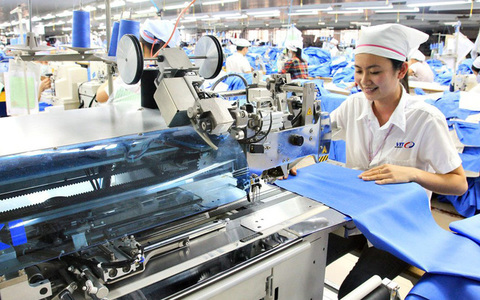
Green production plays an important role in Việt Nam's sustainable textile export in the future. — VNA/VNS Photo
Domestic textile and garment enterprises will face a lot of pressure in production and business in the second half of 2024 due to unstable orders and many other factors.
Although working with many partners, the Southern Textile and Garment Corporation have struggled to close orders because customers are still relatively cautious about market developments.
Nguyễn Hồng Liên, deputy general director of the Huế Textile and Garment JSC, said that in regard to knitwear orders so far in 2024, customers are putting off orders until the third and fourth quarters.
Although the number of orders is increasing, businesses face problems of delivering on time, and firms need to step up productivity pace.
In addition to closely following market developments, businesses in the last six months of the year need to build a new scenario to help stabilise production if the market suddenly reverses compared to the first six months of 2024, Liên said.
The Việt Nam Textile and Apparel Association said the apparel enterprises will still face many difficulties this year, especially the increase in shipping fees due to the geopolitics conflict affecting shipping routes via Red Sea with some customers putting pressure on the textile and garment businesses to share the fee.
There are also added pressures from the European Union market that requires sustainable fashion and textile strategies, starting from ecological design, sustainable production and consumption of textile products, and even recycling of clothing waste.
Many brands also have made a request that from now until 2030, firms must use renewable energy accounting for 30 per cent of power in production, and by 2050, 100 per cent.
In addition, the labour issue is also a big difficulty. There is currently no shortage of orders but a shortage of labour as many staff have returned to their hometowns to seek other job opportunities.
To fill the gap, some localities are recruiting workers from other countries.
Policies on unemployment and social insurance have also created challenges in the labour market with a rise in minimum wage which raises input costs, but product prices have not increased.
Trương Văn Cẩm, deputy chairman of Việt Nam Textile and Apparel Association (VITAS), said the Government's VNĐ120 trillion programme on building social housing needs to be accelerated to ensure workers stay longer.
Cẩm said that in the first quarter of this year, the textile and garment exports improved with higher orders, and many businesses have signed contracts to produce until the third quarter.
Nguyễn Hùng Quý, general director of the Southern Textile and Garment Corporation, said the increase in orders was partly due to moving from China and some Southeast Asian countries to Việt Nam.
In the first three months, the garment and textile sector’s export turnover grew nearly 10 per cent year-on-year to around $10 billion, a momentum for enterprises to fulfil the set target of $44 billion for the whole year.
VITAS said that, since the beginning of the year, global textile and garment companies and supply chains continue to choose Việt Nam to place orders. Việt Nam ranks third in the world for textile and garment exports. — VNS